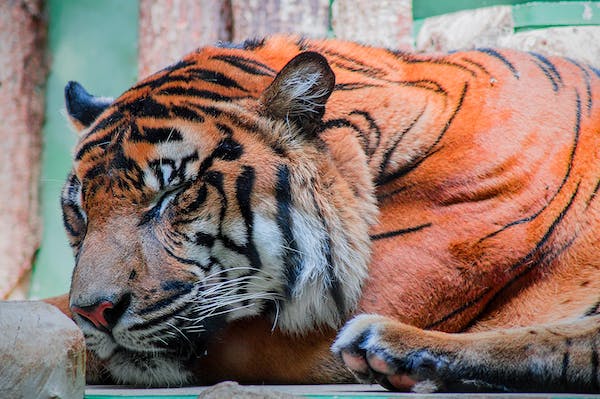The Bengal tiger or Royal Bengal tiger belongs to the Panthera within the big cats and describes its own tiger subspecies, which today is only native to India, Bangladesh, Nepal and Bhutan.
In former times the Bengal tiger was spread on the entire Indian subcontinent, today it stands on the list of the animal species threatened with extinction. According to estimates, only under two thousand specimens live in the wild. In Pakistan, the Royal Bengal Tiger is already extinct.
The Royal Bengal Tiger prefers to live in deep jungles where it has direct access to water.
Due to the intensive clearing of the forests, its natural habitat is continuously decimated, which leads to the drastic decline of the population.
In the dense vegetation of the deep forests, the Bengal tiger hunts mammals of different sizes such as antelopes, deer, wild boars, monkeys, larger rodents or waterfowl. To set them, it slowly creeps up to its victims, then jumps on them from a distance of up to six meters with a leap and pushes them to the ground with its paws.
It kills its victims with a well-aimed bite to the throat, breaking their necks.
The Bengal tiger can grow to over three meters in length, one meter in height, and three hundred kilograms in weight, with males being significantly larger and stronger than females.
The basic color of the coat appears in a bright red-gold, and white on the belly. The broad black stripes cover both the head, trunk and limbs, as well as the long tail. Bred half-albino Bengal tigers may appear pure white, pale yellow with pale markings, or in white base color with black stripes.
Only rarely does the Bengal tiger attack a human. In some regions, however, cases accumulate, which is due to a special, so far unexplained aggression of the animals. Basically, attacks on humans only occur when a female defends the litter or an animal feels harassed. Such incidents never occur near human settlements, but always in the forests, the natural hunting grounds of the Bengal tiger.
After a gestation period averaging one hundred days, the female gives birth to at least two, often more, cubs that are blind during the first weeks of life. They spend about two months in the den before leaving the den for the first time. They remain in the care of their mother for over a year before they begin to hunt independently.
The Bengal tiger has an average life expectancy of about fifteen years in the wild, but can live to be over twenty years old in captivity.
